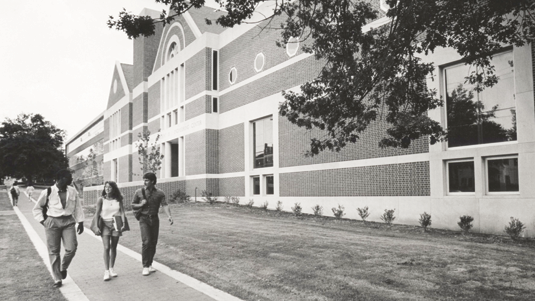
[Continued]
The college ranked high in a number of measures. In 1996, Auburn awarded more than half of the engineering degrees conferred in the state of Alabama. Auburn’s program was second only to the United States Naval Academy in preparing officers for the Navy’s nuclear submarine program, and it ranked tenth nationally in the number of engineering bachelor’s degrees awarded.
Between 1987 and 1996, a ten-year period, the College of Engineering’s budgets totaled $264 million, and only 30 percent — or $79 million — came from state appropriations. Research expenditures exceeded $114 million during that period. During the same decade, 41 percent of Auburn’s honor students studied engineering, a clear indication that despite obstacles, the quality of Auburn’s engineering students had not diminished.
With the American economy in a technology bubble in the late 1990s, employment opportunities for engineering graduates improved, and so did engineering starting salaries. Falling faculty salaries and rising industry salaries, along with a decline in the amount of funding available for fellowships, caused Auburn to again experience a situation similar to that of the 1960s, when new graduates received higher salaries than some of their professors. The demand for engineers also caused graduate student enrollment to decline slightly, as students saw the opportunity for immediate and lucrative careers.
BEGINNING A NEW CENTURY
In September 1998, Benefield became interim dean of engineering and then dean in April 2000. He quickly established a goal of elevating the College of Engineering to one of the top engineering programs in the country. Benefield saw a number of benefits from raising the profile of the College of Engineering among peers in the region, as well as on a national basis. The most obvious was that higher rankings would bring more respect to the college’s academic programs, and make its graduates more sought after in the job market.
But he saw other benefits as well, including the role that Auburn Engineering could play in attracting high-tech industries to Alabama. This would, he hoped, motivate state leaders to support increased funding for higher education and help grow the state’s economy. The impact that Benefield’s leadership brought to Auburn is a story for another day, but it should be noted that his track record has been one of impressive gains in the development of the College of Engineering.
From mainframes to minicomputers: If it takes more than a blink of an eye to pull up a piece of data, run an algorithm or check a spreadsheet, it must be time to buy a new computer. If the internet goes down, you might as well go home for the day.
That’s how we roll now. But only a generation ago, the typical Auburn Engineering student, or professor, would key in a data stack on punch cards, walk it over to the L-Building or Parker Hall, and pick up the results the next morning. Numerical analysis was done on IBM mainframes, and the output was reams and reams of tractor paper. There were no CRT displays much less gooeys (GUIs). But when integrated circuits and microprocessors came onto the scene in the ’70s, things began to change, and change fast. Auburn Engineering jumped on board quickly, with HP, DEC and Harris minicomputers that let users key in programs and receive results on a screen instead of a printout. But even the term minicomputer was relative; the Harris Super mini took up most of a lab in Wilmore.
The first PCs came to the college in the mid ’80s and were incredibly slow compared to mainframes and minis — but there was no waiting in line, the machine was yours. Of course, the PC developed quickly, but it lacked the interconnectivity of a network, which is hard to imagine now. The solution for Auburn Engineering was to invest in several hundred SUN workstations and establish the university’s first network. The SUNs were significantly more powerful than PCs, allowed engineers to design and test increasingly sophisticated models and also made use of 3D imaging. During the ’90s, the college purchased powerful SUN servers that allowed for even faster design and testing of physical models. By the late ’90s, PCs had caught up to SUN in processing speeds, but not interconnectivity. That changed in the early 2000s, when much of the software that had been the domain of DEC, SUN and Silicon Graphics was ported to Windows XP running on inexpensive PCs. Linux had replaced Solaris (SUN’s operating system) by the end of the decade, and Intel based servers began to run the college’s data, email, web and FTP network disk storage functions.
Students are now using smartphones, tablets and pads, even though they all own laptops as well. And while comparing speeds can be problematic — a program may run fast on one machine, and dog along on another — in the raw world of millions of instructions per second, or MIPs, the IBM mainframes discussed earlier ran at about 1 MIP. In 2009, Auburn Engineering acquired a computer cluster with 128 Intel quad core processors capable of performing 5.725 teraflops, or a trillion floating point operations per second. Thirty years from now that will seem incredibly slow, and we will all wonder how we got along.
This article has been adapted from chapters of a manuscript by alum Art Slotkin, ’68 aerospace, detailing the history of Auburn Engineering, from its founding in 1869 to its establishment as a college in 1908 and into the modern age of engineering that we know today.
[miniflickr photoset_id=72157627977012296&sortby=date-posted-asc&per_page=20]